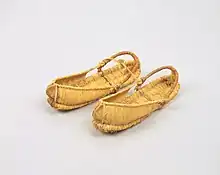| Mituri | |
 | |
| Korean name | |
|---|---|
| Hangul | 미투리 |
| Revised Romanization | mituri |
| McCune–Reischauer | mituri |
Mituri (Korean: 미투리) are traditional Korean woven shoes. They could be made using a variety of techniques and materials; some styles were seen as more luxurious, and therefore reserved for the upper class, although both lower and upper-class people wore the shoes. The shoes could be dyed in a variety of patterns and colors.[1]
They are very similar, especially in form, to jipsin, which are also traditional Korean woven shoes. The difference lies primarily in materials; jipsin are typically made of straw, while mituri are made from a variety of materials, including hemp,[1] Cyperus exaltatus (왕골), or cattail.[2]
The shoes wore down easily; when going on a long journey, people would bring along extra pairs of mituri, depending on the expected amount of walking needed.[2]
A famous example of mituri is those from the tomb of Lee Eung-tae. The shoes were woven using a mixture of hemp and human hair; they were created ritually by Lee's wife, likely to pray for Lee's recovery from illness.[2][3]
See also
- List of Korean clothing
- Waraji – straw sandals from Japan